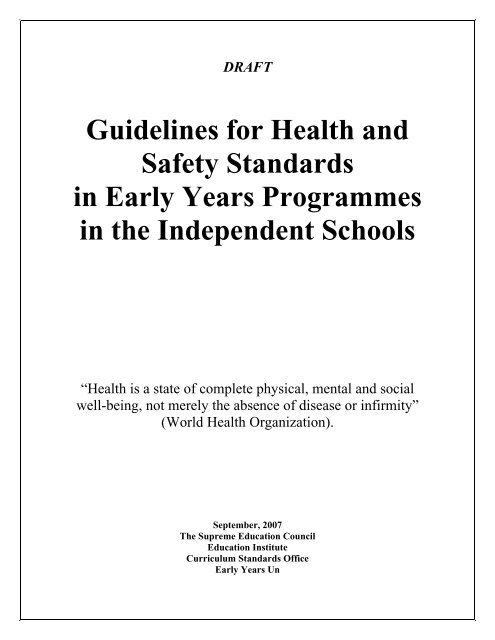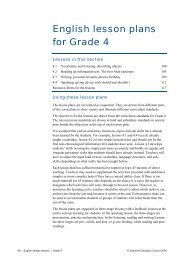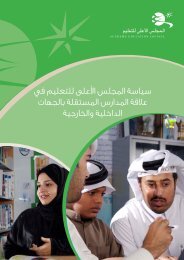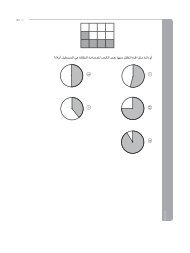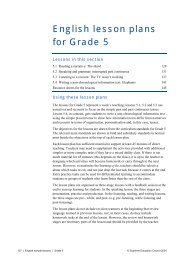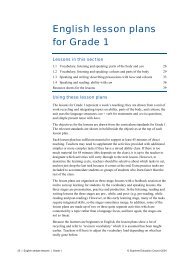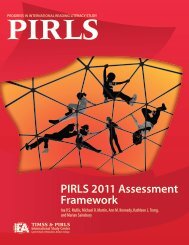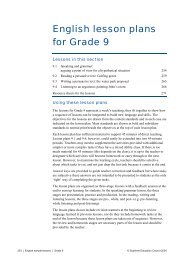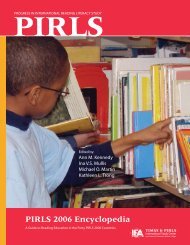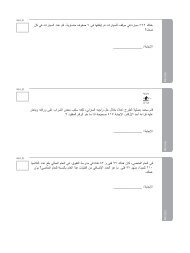Guidelines for Health and Safety Standards in Early Years ...
Guidelines for Health and Safety Standards in Early Years ...
Guidelines for Health and Safety Standards in Early Years ...
Create successful ePaper yourself
Turn your PDF publications into a flip-book with our unique Google optimized e-Paper software.
DRAFT<br />
<strong>Guidel<strong>in</strong>es</strong> <strong>for</strong> <strong>Health</strong> <strong>and</strong><br />
<strong>Safety</strong> St<strong>and</strong>ards<br />
<strong>in</strong> <strong>Early</strong> <strong>Years</strong> Programmes<br />
<strong>in</strong> the Independent Schools<br />
“<strong>Health</strong> is a state of complete physical, mental <strong>and</strong> social<br />
well-be<strong>in</strong>g, not merely the absence of disease or <strong>in</strong>firmity”<br />
(World <strong>Health</strong> Organization).<br />
September, 2007<br />
The Supreme Education Council<br />
Education Institute<br />
Curriculum St<strong>and</strong>ards Office<br />
<strong>Early</strong> <strong>Years</strong> Un
Table of Contents<br />
Introduction<br />
Page No.<br />
1. Child: Staff Ratios <strong>and</strong> Group Sizes<br />
2. Staff Professional Development<br />
3. Outdoor Space <strong>and</strong> Play Areas<br />
4. Indoor Space <strong>and</strong> Learn<strong>in</strong>g Areas<br />
5. Disease Prevention <strong>and</strong> Sanitation<br />
6. Parent-School Communication<br />
7. Transportation<br />
8. Children with Special Needs<br />
9. Emergency Plans <strong>and</strong> Procedures<br />
APPENDICES<br />
Appendix A: References <strong>and</strong> support<strong>in</strong>g documents<br />
Appendix B: Risk Assessment Form<br />
Appendix C: Self-Assessment Checklist<br />
Appendix D: Sample Integrated Teach<strong>in</strong>g Units <strong>for</strong> Young Children<br />
1. Traffic <strong>Safety</strong><br />
2. Fire <strong>Safety</strong><br />
3. Water <strong>Safety</strong><br />
Appendix E : Toxic Plant List<br />
Appendix F : Excursion Procedure<br />
Appendix G : Fire Evacuation
Introduction<br />
The Supreme Education Council regards the ma<strong>in</strong>tenance of health <strong>and</strong> safety<br />
st<strong>and</strong>ards <strong>for</strong> students <strong>in</strong> the Independent Schools to be a high priority. In order to<br />
prevent <strong>in</strong>jury <strong>and</strong> the spread of illness <strong>and</strong> disease it is important that all teachers <strong>in</strong><br />
<strong>Early</strong> <strong>Years</strong> classrooms have a sound knowledge of health <strong>and</strong> safety st<strong>and</strong>ards <strong>and</strong><br />
that they demonstrate the skills necessary to promote developmentally appropriate<br />
learn<strong>in</strong>g experiences. Such st<strong>and</strong>ards are especially important <strong>for</strong> young children <strong>in</strong><br />
the <strong>Early</strong> <strong>Years</strong> Programmes as they transition from home to school sett<strong>in</strong>gs. <strong>Early</strong><br />
<strong>Years</strong> Teachers must be supported by Adm<strong>in</strong>istrators <strong>and</strong> School Leaders to establish<br />
<strong>and</strong> be accountable <strong>for</strong> policies <strong>and</strong> practices to ensure the health, safety <strong>and</strong> welfare<br />
of all children <strong>and</strong> staff <strong>in</strong> each Independent School. The purpose of this document is<br />
to provide a set of guidel<strong>in</strong>es <strong>for</strong> Independent Schools Pr<strong>in</strong>cipals <strong>and</strong> Board of<br />
Trustees to establish safe <strong>and</strong> healthy <strong>in</strong>door <strong>and</strong> outdoor learn<strong>in</strong>g environments <strong>for</strong><br />
<strong>Early</strong> <strong>Years</strong> programs.<br />
1.Child: Staff Ratios <strong>and</strong> Group Sizes<br />
Child: staff ratios <strong>and</strong> group sizes are two of the best <strong>in</strong>dicators <strong>for</strong> determ<strong>in</strong><strong>in</strong>g the<br />
quality of an <strong>Early</strong> <strong>Years</strong> program. Ratios <strong>and</strong> group size significantly effect many<br />
other health <strong>and</strong> safety issues. For example, smaller group size is associated with a<br />
lower risk of <strong>in</strong>fection among children <strong>in</strong> educational sett<strong>in</strong>gs. Lower child: staff<br />
ratios reduce the transmission of disease because teachers are better able to monitor<br />
<strong>and</strong> promote healthy practices <strong>and</strong> behaviors.<br />
Smaller group size improves the teach<strong>in</strong>g behaviors of staff <strong>and</strong> the safety of children.<br />
Teachers <strong>and</strong> teacher assistants <strong>in</strong> small groups spend substantially more time<br />
<strong>in</strong>teract<strong>in</strong>g (prais<strong>in</strong>g, respond<strong>in</strong>g, com<strong>for</strong>t<strong>in</strong>g, question<strong>in</strong>g, <strong>and</strong> <strong>in</strong>struct<strong>in</strong>g) with<br />
children <strong>and</strong> are more actively <strong>in</strong>volved with the children <strong>in</strong> their care .<br />
Lower child: staff ratios are associated with fewer situations <strong>in</strong>volv<strong>in</strong>g potential<br />
danger (such as children climb<strong>in</strong>g on furniture). When <strong>Early</strong> <strong>Years</strong> Centers have<br />
<strong>in</strong>sufficient staff, teachers are often burdened with the care of more children than they<br />
can manage, which <strong>in</strong>creases their stress <strong>and</strong> makes it more likely that they will spend<br />
most of the day direct<strong>in</strong>g the children <strong>in</strong> large group, teacher –controlled activities,<br />
rather than child-focused, child-<strong>in</strong>itiated learn<strong>in</strong>g opportunities.<br />
Research has consistently shown that fewer students per teacher <strong>in</strong> the early grades<br />
can have a positive <strong>in</strong>fluence <strong>in</strong> many areas, <strong>in</strong>clud<strong>in</strong>g higher achievement <strong>and</strong> test<br />
scores, improved attendance, fewer discipl<strong>in</strong>e problems <strong>and</strong> greater engagement <strong>in</strong><br />
school activities. In addition, smaller class size <strong>in</strong> the early grades will allow <strong>for</strong><br />
<strong>in</strong>creased teacher-child <strong>in</strong>teraction, effective differentiation of curriculum <strong>and</strong><br />
<strong>in</strong>struction <strong>and</strong> the promotion of children’s long-term development to ensure a<br />
productive future as a Qatari citizen.
1.1 Recommended Child: Staff ratios <strong>and</strong> Group size <strong>for</strong> <strong>Early</strong> <strong>Years</strong><br />
Educational Sett<strong>in</strong>gs shall be ma<strong>in</strong>ta<strong>in</strong>ed as follows dur<strong>in</strong>g all hours of<br />
operation:<br />
Age Child-staff ratio Maximum group size<br />
3 - 4 year olds 7:1 14<br />
4- 5 year olds 10:1 20*<br />
5 -6 year olds 12:1 22*<br />
6 -7 year olds (Grade 1) 12:1 25**<br />
7 -8 year olds (Grade 2) 15:1 25**<br />
(When there are mixed age groups <strong>in</strong> the same room, the child: staff ratio <strong>and</strong> group size shall be consistent with<br />
the age of the majority of the children).<br />
*K<strong>in</strong>dergarten:<br />
The recommended m<strong>in</strong>imum <strong>in</strong>door space st<strong>and</strong>ards that ensure academic achievement, health <strong>and</strong> safety <strong>for</strong> young<br />
children (age 3 to 6 years) <strong>in</strong> the Independent Schools is 2.5 square meters per child. The KG classrooms <strong>in</strong> the<br />
Independent Schools are approximately 55 sq. meters <strong>in</strong> size <strong>and</strong> there<strong>for</strong>e have adequate space <strong>for</strong> 22 children. This<br />
amount of space per child is necessary to implement the <strong>Early</strong> <strong>Years</strong> Foundation Curriculum (2007) which requires<br />
appropriate classroom space <strong>for</strong> learn<strong>in</strong>g centers <strong>and</strong> corners that are arranged to promote communication, exploration,<br />
creative expression <strong>and</strong> self-awareness. International st<strong>and</strong>ards recommend that class size <strong>for</strong> pre-school <strong>and</strong> KG not<br />
exceed 16 children <strong>in</strong> a group. It is recommended that Independent Schools consider reduc<strong>in</strong>g the number of children <strong>in</strong><br />
KG classrooms to 16-18 by 2010.<br />
**Grades One <strong>and</strong> Two<br />
The current recommended class size <strong>for</strong> primary grades is 25 children, with a strong recommendation to consider<br />
reduc<strong>in</strong>g the number of students <strong>in</strong> Grade One <strong>and</strong> Two classrooms to 20-22 (by 2010).<br />
2. Staff Professional Development<br />
Teachers of young children need to be knowledgeable <strong>in</strong> all areas of safety, <strong>in</strong>clud<strong>in</strong>g fire<br />
safety, traffic safety, water safety, poison safety <strong>and</strong> personal safety. <strong>Early</strong> years<br />
programme staff are responsible <strong>for</strong> regularly check<strong>in</strong>g the <strong>in</strong>door <strong>and</strong> outdoor space <strong>for</strong><br />
health <strong>and</strong> safety hazards <strong>and</strong> they must be able to teach children safe behaviors,<br />
<strong>in</strong>clud<strong>in</strong>g what to do <strong>in</strong> an emergency.<br />
2.1 First Aid<br />
All staff should receive tra<strong>in</strong><strong>in</strong>g <strong>in</strong> pediatric first aid that <strong>in</strong>cludes rescue breath<strong>in</strong>g<br />
<strong>and</strong> chok<strong>in</strong>g. Teachers <strong>and</strong> assistants are <strong>in</strong><strong>for</strong>med of first-aid arrangements: location<br />
of equipment <strong>and</strong> supplies, facilities <strong>and</strong> first-aid personnel, <strong>and</strong> emergency<br />
procedures.<br />
2.2 Risk Assessment<br />
Risk assessment is a careful exam<strong>in</strong>ation of the hazards <strong>in</strong> a sett<strong>in</strong>g <strong>and</strong> an assessment<br />
of whether there are particular hazards that are likely to harm anyone. Risk<br />
assessments are followed with recommendations <strong>for</strong> what precautions should be taken<br />
to reduce the possibility of harm to <strong>in</strong>dividuals or property. All staff should be tra<strong>in</strong>ed<br />
<strong>in</strong> risk assessment <strong>and</strong> the identification of potential hazards <strong>for</strong> young children. (See<br />
APPENDIX B <strong>for</strong> a sample risk assessment <strong>for</strong>m)
2.3 Report<strong>in</strong>g Procedures<br />
All staff must be <strong>in</strong><strong>for</strong>med of school health <strong>and</strong> safety rules, polices <strong>and</strong> procedures,<br />
<strong>in</strong>clud<strong>in</strong>g report<strong>in</strong>g <strong>and</strong> documentation procedures <strong>for</strong> accidents, potential hazards,<br />
children’s illness or health concerns, <strong>and</strong> suspected child abuse <strong>and</strong>/or neglect.<br />
2.4 Child <strong>Health</strong><br />
All staff should receive tra<strong>in</strong><strong>in</strong>g <strong>in</strong> the recognition of <strong>in</strong>fectious <strong>and</strong> non-<strong>in</strong>fectious<br />
diseases e.g. asthma <strong>and</strong> the symptoms associated with allergic reactions common<br />
among young children e.g. food allergies such as peanut butter, seafood, milk<br />
products. Teachers should be vigilant about children’s health status <strong>and</strong> respond<br />
quickly if symptoms of illness or disease are suspected.<br />
2.5 Emergency Plans<br />
All staff <strong>and</strong> children should be tra<strong>in</strong>ed on emergency procedures, <strong>in</strong>clud<strong>in</strong>g fire<br />
evacuation drills. See Appendix D <strong>for</strong> sample.<br />
3.Outdoor Spaces <strong>and</strong> Play Areas<br />
Outdoor spaces <strong>for</strong> young children are an important component of high quality <strong>Early</strong><br />
<strong>Years</strong> programmes <strong>and</strong> should be designed <strong>and</strong> ma<strong>in</strong>ta<strong>in</strong>ed so that children have daily<br />
opportunities to explore, play <strong>and</strong> develop large motor skills <strong>in</strong> a safe environment. If<br />
outdoor play is not advisable on certa<strong>in</strong> days due to weather conditions, then<br />
alternative arrangements must be made available to provide children with<br />
opportunities <strong>for</strong> gross motor (physically active) play.<br />
3.1 Age Appropriate Playgrounds<br />
Preschool <strong>and</strong> school-age children differ dramatically not only <strong>in</strong> physical size <strong>and</strong><br />
ability, but also <strong>in</strong> their cognitive <strong>and</strong> social skills. There<strong>for</strong>e age-appropriate<br />
playground designs should accommodate these differences with regard to type, scale<br />
<strong>and</strong> the layout of the equipment. It is recommended that playground areas be designed<br />
<strong>and</strong> <strong>in</strong>stalled by professionals who adhere to high st<strong>and</strong>ards of safety. Playground<br />
areas should be keep free from small parts that may become detached dur<strong>in</strong>g normal<br />
use or reasonably <strong>for</strong>eseeable abuse of the equipment <strong>and</strong> that present a chok<strong>in</strong>g,<br />
aspiration or <strong>in</strong>gestion hazard to a child.<br />
The follow<strong>in</strong>g is a brief recommended list of equipment designed <strong>for</strong> age 3-5 year<br />
old children:<br />
Rung ladders, stepladders, stairways <strong>and</strong> ramps<br />
H<strong>and</strong>rails (low <strong>and</strong> easy to grab)<br />
Guardrails <strong>and</strong> protective barriers<br />
Stepped plat<strong>for</strong>ms<br />
Climbers – walk<strong>in</strong>g boards, balance beams<br />
Horizontal ladders<br />
S<strong>in</strong>gle –axis sw<strong>in</strong>gs – <strong>in</strong>clude safety zone<br />
Slides- s<strong>in</strong>gle, double, curved<br />
Tracks <strong>for</strong> tricycles, wagons etc.
The follow<strong>in</strong>g is a brief list of playground equipment recommended <strong>for</strong> older<br />
children age 6-12 years:<br />
Cha<strong>in</strong> or cable walks<br />
Free st<strong>and</strong><strong>in</strong>g arch climbers<br />
Free st<strong>and</strong><strong>in</strong>g climb<strong>in</strong>g events with flexible components<br />
Fulcrum seesaws<br />
Log rolls<br />
Long spiral slides ( more than one turn-360’)<br />
Overhead r<strong>in</strong>gs<br />
Parallel bars<br />
Track rides<br />
Sw<strong>in</strong>gs<br />
For more <strong>in</strong><strong>for</strong>mation see website:<br />
3.2 Injury Prevention/<strong>Safety</strong> Rules<br />
Outdoor space should be easily accessible <strong>and</strong> available <strong>for</strong> all young children,<br />
<strong>in</strong>clud<strong>in</strong>g those with physical or other disabilities. <strong>Safety</strong> rules should be posted <strong>and</strong><br />
expla<strong>in</strong>ed by teachers. Staff should conduct risk assessments regularly to ensure<br />
ma<strong>in</strong>tenance <strong>and</strong> safety of outdoor play areas. Anchored play equipment should not<br />
be placed over or immediately adjacent to hard surfaces. Studies have shown that the<br />
primary equipment related <strong>in</strong>jury on playgrounds results from falls from equipment.<br />
A fall onto a shock absorb<strong>in</strong>g surface is less likely to cause a serious <strong>in</strong>jury than a fall<br />
onto a hard surface. The shock absorbency of the selected surfac<strong>in</strong>g material needs to<br />
be calculated <strong>and</strong> adjusted by the playground design team to meet the age <strong>and</strong><br />
developmental needs of the children. Resilient surfaces should extend at least 4 feet<br />
beyond the fall zone of the equipment.<br />
3.3 Play Equipment<br />
Equipment should be sturdy <strong>and</strong> free of sharp po<strong>in</strong>ts or corners, spl<strong>in</strong>ters, protrud<strong>in</strong>g<br />
nails or bolts, loose rusty parts, hazardous small parts, or pa<strong>in</strong>t that conta<strong>in</strong>s lead or<br />
other poisonous materials. All play equipment should be constructed <strong>and</strong> <strong>in</strong>stalled <strong>in</strong><br />
such a manner as to be safe <strong>for</strong> use by children ( e.g. height should not be excessive;<br />
h<strong>and</strong>rails should match the developmental levels <strong>and</strong> the equipment should not be a<br />
source of potential entrapment). There should be no p<strong>in</strong>ch, crush, or shear po<strong>in</strong>ts on<br />
or underneath equipment that would be accessible by children.<br />
Outdoor play equipment should not be coated or treated with toxic materials.<br />
3.4 Environmental Considerations/Hazards<br />
Outdoor activity space is enclosed by structures <strong>and</strong>/or fences <strong>and</strong> gates that are<br />
ma<strong>in</strong>ta<strong>in</strong>ed so that children cannot leave without an adult’s help. All areas <strong>for</strong> play<br />
are well-dra<strong>in</strong>ed <strong>and</strong> suitably surfaced with impact-absorb<strong>in</strong>g materials to reduce risk<br />
of <strong>in</strong>jury. All pieces of playground equipment should be surrounded by a resilient, nocombustible<br />
surface. Hard surfac<strong>in</strong>g materials, such as asphalt or concrete, are
unsuitable <strong>for</strong> use under <strong>and</strong> around playground equipment unless they are required as<br />
a base <strong>for</strong> shock absorb<strong>in</strong>g material such as rubber mats. Earth surfaces such as soils<br />
or hard packed dirt are not recommended because they have poor shock absorb<strong>in</strong>g<br />
properties. Similarly grass <strong>and</strong> turf are not recommended because wear <strong>and</strong><br />
environmental conditions can reduce their effectiveness <strong>in</strong> absorb<strong>in</strong>g shock dur<strong>in</strong>g a<br />
fall.<br />
Other hazards <strong>in</strong>clude impact by sw<strong>in</strong>gs <strong>and</strong> other mov<strong>in</strong>g equipment <strong>and</strong> collisions<br />
with stationary equipment or support structures that are not wrapped <strong>in</strong> impact<br />
absorb<strong>in</strong>g material. Fatal <strong>in</strong>juries reported most commonly on playgrounds <strong>in</strong>clude<br />
falls, entanglement of cloth<strong>in</strong>g <strong>in</strong> ropes tied or caught on equipment, head entrapment<br />
<strong>in</strong> open<strong>in</strong>gs, impact from equipment tip over or structural failure <strong>and</strong> impact by<br />
mov<strong>in</strong>g sw<strong>in</strong>gs.<br />
3.5 Shade <strong>and</strong> Cover<strong>in</strong>gs <strong>for</strong> Outdoor Play Areas<br />
Outdoor play areas should offer sufficient shade (natural l<strong>and</strong>scap<strong>in</strong>g, trees <strong>and</strong>/or<br />
tented structures) cover<strong>in</strong>g at least 50% of the play area so that children can spend<br />
time outdoors without be<strong>in</strong>g <strong>in</strong> the direct sunlight <strong>for</strong> extended periods.<br />
Children should be encouraged to wear a hat when play<strong>in</strong>g <strong>in</strong> un-shaded areas.<br />
3.6 Adult Supervision<br />
Indoor <strong>and</strong> outdoor playgrounds that meet basic health <strong>and</strong> safety st<strong>and</strong>ards may still<br />
present hazards to children <strong>in</strong> the absence of adequate supervision. Because all<br />
playgrounds present some challenge <strong>and</strong> because children can be expected to use<br />
equipment <strong>in</strong> un<strong>in</strong>tended <strong>and</strong> un anticipated ways, adult supervision is recommended<br />
at all times. It is important to recognize that children aged 3-6 years will require more<br />
attentive supervision on playgrounds than older children.<br />
3.7 Pest Control<br />
Outdoor play spaces should be kept free of animal wastes <strong>and</strong> s<strong>and</strong> box areas need to<br />
be covered when not <strong>in</strong> use. Pesticides should not be used on or near surfaces where<br />
children play.<br />
3.8 Ma<strong>in</strong>tenance<br />
All outdoor activity areas should be ma<strong>in</strong>ta<strong>in</strong>ed <strong>in</strong> a clean <strong>and</strong> safe condition by<br />
remov<strong>in</strong>g debris, dilapidated structures, broken or worn play equipment, build<strong>in</strong>g<br />
supplies, glass, sharp rocks, twigs, toxic plants, <strong>and</strong> other <strong>in</strong>jurious materials. The<br />
area should be well-dra<strong>in</strong>ed with no st<strong>and</strong><strong>in</strong>g water.<br />
See Appendix E –Toxic Plant list.<br />
4. Indoor Spaces <strong>and</strong> Learn<strong>in</strong>g Areas<br />
4.1 Space St<strong>and</strong>ards<br />
Internationally, the recommended m<strong>in</strong>imum <strong>in</strong>door space st<strong>and</strong>ards that ensure<br />
academic achievement, health <strong>and</strong> safety <strong>for</strong> young children (age 3 to 6 years) <strong>in</strong> the<br />
is 4 square meters per child. Some countries use st<strong>and</strong>ards that are more or less than
this amount. In the Independent schools the current accepted m<strong>in</strong>imum space amount<br />
<strong>for</strong> primary children is 2.5 square meters per child.<br />
4.2 W<strong>in</strong>dows <strong>and</strong> Doors<br />
All w<strong>in</strong>dows above ground level <strong>in</strong> areas used by children under 5 years of age<br />
should be constructed, adapted, or adjusted to limit the exit open<strong>in</strong>g accessible to<br />
children to less than 6 <strong>in</strong>ches, or to be otherwise protected with guards that do not<br />
block outdoor light.<br />
Str<strong>in</strong>gs <strong>and</strong> cords ( e.g. those that can be found on w<strong>in</strong>dow shades) that are long<br />
enough to encircle a child’s neck ( 6 <strong>in</strong>ches or more) should not be accessible to<br />
children.<br />
No lock or fasten<strong>in</strong>g should be <strong>in</strong>stalled that prevents free escape from the <strong>in</strong>terior of<br />
the build<strong>in</strong>g. All door hardware <strong>in</strong> areas used by school-age children should be with<strong>in</strong><br />
reach of the children.<br />
Any glassed area accessible to children is safety glazed or effectively guarded by<br />
barriers which prevent a child from strik<strong>in</strong>g or fall<strong>in</strong>g aga<strong>in</strong>st the glass.<br />
4.3 Stairs<br />
All stairs used by children on a daily basis should be equipped with age appropriate<br />
height h<strong>and</strong>rails <strong>and</strong> non slip material.<br />
4.4 Electrical Fixtures <strong>and</strong> Outlets<br />
Electrical outlets accessible to children should be covered with child-resistant covers<br />
or be of the child-proof type.<br />
4.5 Heat<strong>in</strong>g, Ventilation <strong>and</strong> Cool<strong>in</strong>g<br />
All rooms used by children should be heated, cooled <strong>and</strong> ventilated to ma<strong>in</strong>ta<strong>in</strong> a<br />
com<strong>for</strong>table temperature (19 degrees is recommended), humidity level <strong>and</strong> air<br />
exchange <strong>and</strong> to avoid the accumulation of objectionable odors <strong>and</strong> harmful fumes.<br />
4.6 Water Temperature<br />
The temperature of all warm water taps accessible to children is no higher than 40<br />
degrees C.<br />
4.7 Pest Control<br />
Classroom <strong>and</strong> outdoor spaces should be kept free of animal wastes, <strong>in</strong>sect, rodents,<br />
or other pest <strong>in</strong>festations, <strong>and</strong> shall not provide shelter to pests.<br />
4.8 Classroom Arrangement<br />
Classroom furniture needs to be arranged so as to provide unobstructed views <strong>for</strong><br />
teachers at all times. Cubicles, storage cab<strong>in</strong>ets <strong>and</strong> shelv<strong>in</strong>g needs to be stable <strong>and</strong><br />
secured to the floor or wall to prevent danger from tipp<strong>in</strong>g over. Equipment such as
computers <strong>and</strong> televisions must be secured to carts or tables to prevent these items<br />
from fall<strong>in</strong>g on children.<br />
4.9 Indoor Playground<br />
Indoor floor cover<strong>in</strong>g should consist of v<strong>in</strong>yl or rubber coat<strong>in</strong>g which has some<br />
ability to cushion children from falls while runn<strong>in</strong>g/ play<strong>in</strong>g. Floor surfaces should be<br />
adequately slip resistant under all conditions of normal use <strong>and</strong> easily cleaned.<br />
Climb<strong>in</strong>g equipment must have shock absorb<strong>in</strong>g mats or cushion<strong>in</strong>g that extends at<br />
least 4 feet beyond the fall zone.<br />
Concrete pillars or other central hard structures need to covered with cushion<strong>in</strong>g or<br />
impact resistant material.<br />
4.10 Equipment, Toys <strong>and</strong> Materials<br />
Toys or objects hav<strong>in</strong>g a diameter of less than 1 <strong>and</strong> ¼ <strong>in</strong>ch, objects with removable<br />
parts <strong>and</strong> a diameter less than 1 <strong>and</strong> ¼ <strong>in</strong>ch, toys with sharp po<strong>in</strong>ts <strong>and</strong> edges, plastic<br />
bags, <strong>and</strong> Styrofoam objects should not be accessible to children under 4 years of age.<br />
Young children should not be permitted to <strong>in</strong>flate balloons or to have access to<br />
deflated or under-<strong>in</strong>flated balloons.<br />
Furniture, furnish<strong>in</strong>gs, fitt<strong>in</strong>gs, equipment <strong>and</strong> materials are kept safe, hygienic <strong>and</strong><br />
ma<strong>in</strong>ta<strong>in</strong>ed <strong>in</strong> good condition. Positive steps are taken to prevent damage to people<br />
<strong>and</strong> property result<strong>in</strong>g from unsecured heavy furniture, fixtures <strong>and</strong> equipment<br />
fall<strong>in</strong>g.<br />
4.11 Clean<strong>in</strong>g of Equipment, Toys <strong>and</strong> Materials<br />
Indoor environmental surfaces associated with children’s activities, such as table tops,<br />
should be cleaned <strong>and</strong> dis<strong>in</strong>fected when they are soiled or at least daily. All<br />
frequently touched toys shall be cleaned daily <strong>and</strong> other toys <strong>and</strong> materials cleaned<br />
weekly.<br />
4.12 First Aid Supplies<br />
A readily available first aid kit should be ma<strong>in</strong>ta<strong>in</strong>ed by each <strong>Early</strong> <strong>Years</strong> Program,<br />
one to be taken on field trips <strong>and</strong> out<strong>in</strong>gs away from the site. Each kit shall be a<br />
closed conta<strong>in</strong>er <strong>for</strong> stor<strong>in</strong>g first aid supplies, accessible to staff <strong>and</strong> out of reach of<br />
children. Kits shall be restocked after each use <strong>and</strong> <strong>in</strong>ventory should be conducted<br />
monthly. For a specific list of items to <strong>in</strong>clude <strong>in</strong> the kit see APPENDIX C Self –<br />
Assessment Checklist.<br />
5. Disease Prevention <strong>and</strong> Sanitation<br />
5.1 H<strong>and</strong> wash<strong>in</strong>g<br />
Wash h<strong>and</strong>s often. Most adults underst<strong>and</strong> that the most important th<strong>in</strong>g you can do<br />
to keep from gett<strong>in</strong>g sick is to wash your h<strong>and</strong>s, but kids need to be taught this<br />
message <strong>and</strong> then have it frequently re<strong>in</strong><strong>for</strong>ced. People pick up germs from other
sources <strong>and</strong> then become <strong>in</strong>fected when they touch their eyes, nose or mouth (or put<br />
<strong>in</strong>fected toys <strong>and</strong> other items <strong>in</strong> their mouths as commonly occurs with youngsters).<br />
Germs are easily spread directly to others or onto surfaces that people touch, <strong>and</strong><br />
more than a common cold can be caught through the spread of germs--some serious<br />
diseases such as hepatitis A, men<strong>in</strong>gitis, <strong>and</strong> <strong>in</strong>fectious diarrhea are easily spread.<br />
Children should be rem<strong>in</strong>ded to wash their h<strong>and</strong>s be<strong>for</strong>e, dur<strong>in</strong>g <strong>and</strong> after food is<br />
prepared; be<strong>for</strong>e <strong>and</strong> after you eat; after us<strong>in</strong>g the bathroom; after h<strong>and</strong>l<strong>in</strong>g animals or<br />
animal waste such as chang<strong>in</strong>g a cage or cat box; whenever h<strong>and</strong>s are dirty or kids<br />
have been outside play<strong>in</strong>g; <strong>and</strong> more frequently when anyone <strong>in</strong> the classroom, or<br />
home is sick.<br />
5.2 Cover a cough.<br />
Children need to be taught how to do this to help prevent spread of germs. Inevitably,<br />
young children aren't near a tissue when the urge to cough or sneeze occurs, <strong>and</strong><br />
spread (or literally spray) germs by unwitt<strong>in</strong>gly <strong>in</strong>fect<strong>in</strong>g others. Teachers should<br />
teach children to cough <strong>in</strong>to the crook of their arm, <strong>in</strong>to their sleeve, or even <strong>in</strong> their<br />
h<strong>and</strong>, <strong>and</strong> then to immediately wash their h<strong>and</strong>s. Some teachers have turned "cover<br />
your cough" <strong>in</strong>to a game or type of positive re<strong>in</strong><strong>for</strong>cement when kids are caught<br />
cover<strong>in</strong>g their cough correctly.<br />
5.3 Toilets<br />
Toilet rooms, flush toilets <strong>and</strong> toilet tra<strong>in</strong><strong>in</strong>g equipment <strong>and</strong> fixtures should be<br />
cleaned <strong>and</strong> sanitized at least daily <strong>and</strong> when obviously soiled <strong>and</strong> shall be<br />
ma<strong>in</strong>ta<strong>in</strong>ed <strong>in</strong> good repair.<br />
Toilets <strong>and</strong> s<strong>in</strong>ks <strong>for</strong> young children should be child-scaled <strong>and</strong> need to be separate<br />
from adult toilets , or from toilets used by security staff or visitors.<br />
Toilet<strong>in</strong>g areas need to be dist<strong>in</strong>ctly separate from food preparation areas to dim<strong>in</strong>ish<br />
the chance of staff <strong>in</strong>advertently go<strong>in</strong>g directly from toilet<strong>in</strong>g areas to food<br />
preparation areas without h<strong>and</strong> wash<strong>in</strong>g<br />
It is recommended that the site provides one toilet, s<strong>in</strong>k <strong>and</strong> dr<strong>in</strong>k<strong>in</strong>g founta<strong>in</strong> <strong>for</strong><br />
every 12 children. Separate boys <strong>and</strong> girls facilities should be available <strong>for</strong><br />
K<strong>in</strong>dergarten children.<br />
5.4 Food Preparation <strong>and</strong> <strong>Safety</strong><br />
Children should not be allowed <strong>in</strong>to food preparation areas without adult supervision.<br />
When food is prepared it is served at times <strong>and</strong> <strong>in</strong> variety, quantity <strong>and</strong> quality so as<br />
to meet the nutritional needs of the children. Food is prepared, served <strong>and</strong> stored<br />
hygienically. When food is provided by the parents, guidel<strong>in</strong>es are offered that<br />
promote healthy eat<strong>in</strong>g habits.<br />
Children are supervised while eat<strong>in</strong>g <strong>in</strong> order to m<strong>in</strong>imize the risk of children<br />
chok<strong>in</strong>g.
An ample supply of potable dr<strong>in</strong>k<strong>in</strong>g water is available to children at all times <strong>and</strong><br />
older children are able to access this water <strong>in</strong>dependently.<br />
5.5 Universal Precautions<br />
Staff shall adopt universal precautions <strong>and</strong> all spills of body fluids shall be cleaned<br />
<strong>and</strong> dis<strong>in</strong>fected immediately.<br />
6. Parent-School Communication<br />
6.1 Medical Records/Medications<br />
The child’s medical history <strong>and</strong> general health status is to be documented <strong>in</strong> the<br />
school enrolment <strong>for</strong>m. Any ongo<strong>in</strong>g medication <strong>and</strong> procedures e.g <strong>for</strong> asthma,<br />
diabetes are to be provided to the school nurse <strong>and</strong> to be shared with appropriate<br />
classroom<br />
6.2 Developmental Progress<br />
<strong>Early</strong> <strong>and</strong> ongo<strong>in</strong>g communication with parents i.e. structured parent consultations are<br />
scheduled to discuss the child’s growth <strong>and</strong> development, child guidance techniques,<br />
specific health issues <strong>and</strong> developmental concerns<br />
6.3 Illness policies/Injury Log<br />
These are to be kept by the school nurse <strong>and</strong> shared with teachers where relevant.<br />
6.4 Medical <strong>and</strong> Dental Emergencies<br />
Emergency contact numbers should always be available <strong>in</strong> the children’s enrolment<br />
<strong>for</strong>m. These umbers should be current. The school nurse is to contact emergency<br />
services <strong>in</strong> consultation with Senior management.<br />
7.Transportation<br />
7.1 Vehicle <strong>and</strong> Traffic <strong>Safety</strong> rules<br />
If the school has school buses, children should be taught bus <strong>and</strong> traffic safety rules.<br />
See Appendix D – traffic <strong>Safety</strong> Teach<strong>in</strong>g Unit<br />
7.2 Field trips: policy <strong>and</strong> procedure<br />
Field Trips are an important part of the children’s learn<strong>in</strong>g. They re<strong>in</strong><strong>for</strong>ce<br />
knowledge, give first h<strong>and</strong> experience <strong>and</strong> are <strong>in</strong>terest<strong>in</strong>g, excit<strong>in</strong>g <strong>and</strong> fun<br />
experiences <strong>for</strong> young children. These trips should be planned appropriately <strong>in</strong> order<br />
to ma<strong>in</strong>ta<strong>in</strong> safety. They should be relevant <strong>and</strong> age appropriate.<br />
See Appendix F <strong>for</strong> sample policy <strong>and</strong> procedure.<br />
8.Children with Special Needs<br />
8.1 Access<br />
The <strong>Early</strong> <strong>Years</strong> classrooms <strong>and</strong> outdoor areas will be accessible <strong>for</strong> all children,<br />
<strong>in</strong>clud<strong>in</strong>g children who use wheelchairs or have other disabilities. Accessibility
<strong>in</strong>cludes access to build<strong>in</strong>gs, toilets, s<strong>in</strong>ks, dr<strong>in</strong>k<strong>in</strong>g founta<strong>in</strong>s. All exits <strong>and</strong> steps<br />
should be unobstructed <strong>and</strong> have approved ramps <strong>for</strong> evacuation.<br />
8.2 Hear<strong>in</strong>g <strong>and</strong> Vision Screen<strong>in</strong>g<br />
If a child seems to tune th<strong>in</strong>gs out, the problem might be with his hear<strong>in</strong>g. Although<br />
there are classic symptoms of hear<strong>in</strong>g loss, they often go unnoticed or are written off<br />
as slow development <strong>in</strong> young children. The truth is that hear<strong>in</strong>g loss can be the cause<br />
of slow development. If left undetected it can lead to speech <strong>and</strong> language disorders,<br />
poor per<strong>for</strong>mance <strong>in</strong> school <strong>and</strong> delayed social skills.<br />
8.3 Emergency Medical Procedures<br />
All children with special medical needs or conditions should have a written plan <strong>for</strong><br />
emergency medical backup or medical procedures. The plan should describe the<br />
special emergency procedures that will be used by the teacher or assistant or by a<br />
physician or nurse.<br />
9.Emergency Plans <strong>and</strong> Procedures<br />
Designated areas <strong>for</strong> evacuation purposes do not unnecessarily place children at<br />
further risk. Staff <strong>and</strong> children are familiar <strong>and</strong> com<strong>for</strong>table with evacuation<br />
procedures <strong>and</strong> practice drills regularly.<br />
APPENDICES<br />
APPENDIX A :References<br />
US Consumer Product <strong>Safety</strong> Commission http://www.cpsc.gov<br />
US Department of <strong>Health</strong> <strong>and</strong> Human Services, <strong>Health</strong> Resources <strong>and</strong> Services<br />
Adm<strong>in</strong>istration, Maternal <strong>and</strong> Child <strong>Health</strong> Bureau, “Stepp<strong>in</strong>g Stones to Us<strong>in</strong>g<br />
Car<strong>in</strong>g <strong>for</strong> our Children”, National <strong>Health</strong> <strong>and</strong> <strong>Safety</strong> Per<strong>for</strong>mance St<strong>and</strong>ards<br />
<strong>Guidel<strong>in</strong>es</strong> <strong>for</strong> Out-of-Home Child Care Programs<br />
APPENDIX B: Risk Assessment Form<br />
APPENDIX C: Self-Assessment Checklist<br />
APPENDIX D: Sample Teach<strong>in</strong>g Units<br />
Traffic <strong>Safety</strong><br />
Fire <strong>Safety</strong><br />
Water <strong>Safety</strong><br />
APPENDIX E: Toxic Plant List<br />
APPENDIX F: Excursion Policy <strong>and</strong> Procedure<br />
APPENDIX G: Fire Evacuation Procedure


